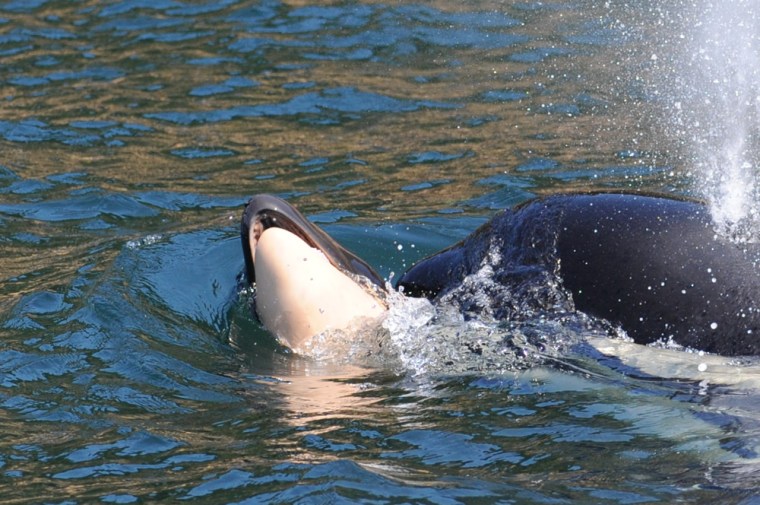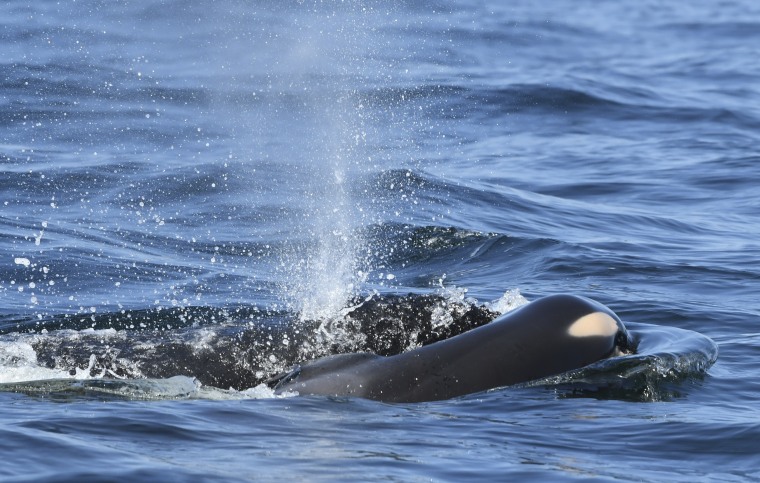The gut punches came in quick succession this summer in the Pacific Northwest, a place where it seems like everyone is, or knows, a killer whale fan.
First, video crews captured an orca known as J35 carrying and coaxing her stillborn calf for 17 anguishing days, a mother seemingly unwilling to accept her child’s death. A few weeks later, a rambunctious young orca — known for her frequent breaching in Puget Sound — went missing. The whale nicknamed Scarlet was soon declared dead, at just 4 years old.
A University of Washington biologist pronounced herself “shocked and heartbroken” at the death of the newborn. Others reacted with poems, songs and and online tributes. A Seattle Times headline described “the grief felt around the world.”

The pair of deaths has galvanized the state of Washington, where scientists, environmentalists and politicians say they believe 2018 could be a year of decisive action to protect a unique group of killer whales, the so-called southern resident orcas. Researchers believe the southern resident population has declined to just 74. Researchers believe they once numbered close to 200.
Washington Gov. Jay Inslee already had formed a task force in March to study ways to preserve and restore the local killer whale population, which spends summers in Puget Sound and environs.
“We are feeling these great passions now and we need to forge that passion in our hearts into action,” Inslee said in a video released on Facebook after the young whales died. “We do know that as the orca goes, so go we.”
Orca populations in some of the world's oceans remain robust, particularly around the the Arctic and Antarctic. But the killer whales that spend summers near Seattle — and range as far as Alaska and Central California the rest of the year — face multiple threats that have led to the U.S. government to list them as endangered.
The orcas have been forced on a near-starvation diet by declining salmon stocks. Their immune and reproductive systems have been battered by pollutants. And they have been cursed by their very popularity — with curious humans frequently interrupting their hunt for the meaty Chinook salmon that are their mainstay.
That trio of challenges has been created over a century and could take that long, or longer, to be reversed. That makes the southern resident orcas fragile, particularly given how much they have struggled to reproduce. Two-thirds of the group’s pregnancies from 2007 to 2014 failed. Not a single calf has survived more than three years.
“I worry that we may be too late,” said Ken Balcomb, of the Center for Whale Research on San Juan Island, who has studied the killer whales for more than 40 years. “That personally saddens me. But working to recover an ecosystem of this abundance is still well worthwhile.”
Killer whales need a massive intake of food to maintain bodies that can grow to 6 tons and up to 32 feet in length. While some orca groups are more transient and feed primarily on other mammals, like seals, the southern resident whales get the vast majority of their calories from giant, fat-rich Chinook salmon.
The problem is that Chinook are themselves in the midst of a calamitous decline. About 1.3 million of the fish were caught by humans from California to Alaska in 2017, according to monitors for the international treaty that regulates catches of the fish. That is down from the 4 million or more Chinook caught each year during their peak, said Balcomb.
Insults to the Chinook ecosystem are multiple and complex. The creatures, prized by native groups for millennia, have been mightily over-fished for decades. Dams on many rivers have made it difficult for the fish to reach their spawning grounds. And fish that Chinook eat — like smelt and sand lance — also have trouble reproducing because the sandy beaches where they lay their eggs have disappeared under waves of development.
Orcas, the largest member of the dolphin family, are among the most closely watched wild creatures on Earth, scientists say. They are particularly susceptible to malnutrition, which make them more in danger from the witches brew of pollutants stored in forage fish — everything from the pesticide DDT to hydrocarbons from oil spills.

Also problematic for orcas are PCBs, the ubiquitous, super-resilient compounds found in everything from hydraulic fluid and electric transformers to paints and plastics. A team of researchers recently concluded that about half of the 19 killer whale populations they studied worldwide were at risk of extinction because of PCB contamination.
A 2014 report from the National Oceanic and Atmospheric Administration (NOAA) called the southern resident orcas “among the most contaminated marine mammals in the world.” The problem is that contaminants tend to become more concentrated as they move up the food chain and even more densely grouped in the whale’s blubber.
Killer whales burn those fatty stores more readily when they are malnourished. And mothers pass the poisons on to their young, both during gestation and in the milk they feed their young.
As hard as many experts are trying to preserve the southern resident killer whales, some of their fellow humans aren't helping. The giant creatures rely on echo-location to track salmon and research suggests that the southern resident group probably loses several hours a day of foraging because boat noises interrupt their guidance systems.
The Washington Department of Fish and Wildlife this summer asked boaters to voluntarily remain a quarter mile off the west coast of tourist-laden San Juan Island, north of Seattle, to give the whales a safe zone.
A host of longer-term fixes from Inslee’s task force are due to be presented in November. They could include a requirement to double the current 200-yard distance whale watching boats are required to stay away from whales; a dramatic increase in fines, possibly up to $250,000, for developers who encroach on forage-fish breeding beaches; and increasing water releases from dams on the Columbia River, a key Chinook spawning ground.
Salmon recovery is the most crucial and complicated issue. It crosses an international border, because the fish range into neighboring Canada. Increased limits on already tightly-constrained Chinook takes would involve multiple parties, from sportfishing groups and native tribes to commercial fishermen.
Another perennial proposal to restore both salmon and killer whales is for removal of dams on the Snake River and other rivers where the Chinook lay their eggs. But the dams have their own constituencies: the power companies that use them to create hydro-power, the farmers who rely on them to corral irrigation water and the recreation enthusiasts who enjoy fishing and boating on their lakes.
“Not everyone agrees on what is the most important thing to do or on how to focus limited resources to support a recovery,” said Lynne Barre, coordinator of the orca recovery effort for NOAA’s fisheries wing. “So that makes this really complex.”
Kevin Ranker, a one-time environmentalist who is now a state senator, recalls his first encounter with the orcas when he spent his first night on San Juan Island in the mid-1990s. With the windows open on a warm summer night, he awoke to what sounded like “incredibly loud snoring.” When he walked on to the dock, he saw killer whales, breathing deeply through their blow holes.
“It was absolutely incredible. Experiences like that can change your life forever and make you completely dedicated to conservation,” recalled Ranker, a prime mover on legislation to help the orcas.
He is another person who believes the deaths of the two young whales this summer have turned the tide.
“This is not a time for compromise and for moving slowly,” said Ranker. “This is a time for bold actions.”


